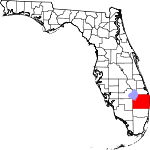Lake Worth Beach, Florida
Lake Worth Beach is a city in Palm Beach County, Florida, United States, located about 64 miles north of Miami, its name from the body of water along its eastern border known as the Lake Worth Lagoon. The lake itself was named for General William J. Worth, who led U.S. forces during the last part of the Second Seminole War. As of 2010, the population estimated by the U.S. Census Bureau was 34,910.[6] It is a principal city of the Miami metropolitan area, which was home to an estimated 6,012,331 people in 2015.[11]
Lake Worth Beach, Florida | |
|---|---|
City | |
| City of Lake Worth Beach | |
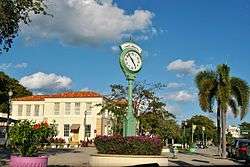 Lake Worth Beach | |
| Motto(s): | |
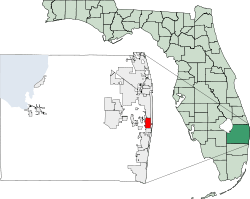 Location of Lake Worth Beach, in Palm Beach County, Florida | |
| Coordinates: 26°37′11″N 80°3′31″W | |
| Country | |
| State | |
| County | |
| Settled (Jewell Settlement) | Circa 1885[3] |
| Platted (Jewell) | 1909[3] |
| Incorporated | June 14, 1913[3] |
| Named for | Lake Worth Lagoon and William J. Worth |
| Government | |
| • Type | Council-Manager |
| • Mayor | Pam Triolo |
| • Vice Mayor | Andy Amoroso |
| • Councilmembers | Omari Hardy, Herman Robinson, and Vice Mayor Pro Tem Scott Maxwell |
| • City Manager | Michael Bornstein |
| • City Clerk | Deborah "Debbie" Andrea |
| Area | |
| • City | 6.67 sq mi (17.27 km2) |
| • Land | 5.88 sq mi (15.22 km2) |
| • Water | 0.79 sq mi (2.05 km2) 12.69% |
| Elevation | 16 ft (5 m) |
| Population | |
| • City | 34,910 |
| • Estimate (2018)[7] | 38,267 |
| • Density | 6,434.99/sq mi (2,484.65/km2) |
| • Metro | 5,463,857 |
| 2010 Census | |
| Time zone | UTC−5 (EST) |
| • Summer (DST) | UTC−4 (EDT) |
| ZIP codes | 33460, 33461[8] |
| Area code | 561 |
| FIPS code | 12-39075[9] |
| GNIS feature ID | 0285292[10] |
| Website | www |
History
Indigenous people known as the Jaega were the earliest reported inhabitants of the section of the Florida Atlantic coast in the areas of Martin and Palm Beach Counties. Remains of shell mounds can be found near the Jupiter inlet, inland in what is now Boynton Beach and just south of the Boynton Inlet, indicating pre-Columbian Jaega habitation.[12]
The city's first settlers were Samuel and Fannie James, an African American couple and reported to be ex-slaves, known as the Black Diamonds, who settled on the shores of the Lake Worth Lagoon near the current 5th Avenue South in 1885. (The stone monument located at the northwest corner of Lucerne Avenue and J Street inaccurately uses the date 1883, due to a transcription error). The couple made a claim for their land under the Homestead Act in 1885 and received a receipt for their claim on February 1, 1887. Their holdings, originally 187 acres (76 ha), increased over time and came to include an additional 160 acres (65 ha) of homestead land south of Lake Avenue between M and F Streets, 160 acres (65 ha) in College Park acquired from the estate of William Stephan, where Fannie ran a pineapple farm, and 160 acres (65 ha) to the south between the current Dixie and Federal Highways, acquired from Swedish immigrants, Olai and Sarah Gudmundsen. The Jameses sold off most of this acreage in 10 and 20 acres parcels to new residents and investors.[13] After Samuel's death in 1909, Fannie sold her remaining 156 acres to developer, Palm Beach Farms company, keeping only an acre and a quarter farmette. The farmette lay outside the new city limits as required by the segregation provisions of the 1913 Town of Lake Worth charter.[14]
The initial name for the post office was Jewell (sometimes spelled Jewel).[15] Fannie James was the first postmaster. The post office was located in a small dry goods shop which the couple operated to serve the lake traffic that connected the small pioneer homesteads located along the banks of the Lake Worth Lagoon. Area pioneers report that Jewell was included as a stop on the route of the barefoot mailman via the Celestial Railroad by July 1889.[16]
After Henry Flagler extended his rail line south from West Palm Beach to Miami in 1896, a land development scheme was created to plant a townsite between the railroad and the lake. Purchasers of agricultural lots, west of town, would also receive a small 25 foot lot within the City of Lake Worth,[17] closer to the beach. The developer, Bryant & Greenwood, proposed to name the town Lucerne,[18] however the United States Postal Service refused to accept the name because there already was a Lake Lucerne post office north of Miami in Dade County, which is now a neighborhood in Miami Gardens. Therefore, the city fathers settled on the name Lake Worth, for the lake on which the fledgling town was sited. One of the main streets was named Lucerne Avenue instead.
In April 1911, "A solitary Indian mound surrounded by wild woods marked the spot where flourishing Lake Worth is now growing beyond the most vivid imagination", according to a promotional article published in the Lake Worth Herald,[19] The population of the nascent city stood at 38 in July 1912.[20] During that busy year, the library, schoolhouse, newspaper, Women's Club, Chamber of Commerce and first church were established.[20] By the year's end, publication of the "city's first census showed 308 residents, 125 houses, 10 wagons, seven automobiles, 36 bicycles and 876 fowls."[21]
The town was growing so fast that a new addition was platted in that inaugural year. The area along the Intracoastal from 5th Avenue South to 15th Avenue South still bears the name Addition 1. "In the new addition, the Lake front has been divided into large lots covered with palm and tropical growth, where we expect to see charming villas and winter homes spring up as by enchantment. It will be the fashionable part of town, where the wealthy of the earth can display their artistic taste and make ideal homes. These lots are selling so fast that but very few are left."[19] Included in the new addition were South Palm Park, a boat dock and P Street (now South Palmway) with its vibrant, green median and collection of 31 species of palm trees.
Later history
Lake Worth Beach was incorporated as the "Town of Lake Worth" in June 1913. Many of the first residents were farmers from other parts of the American south and mid-west, looking to benefit from the growing winter vegetable market of the time. The city benefited with the rest of south Florida during the Florida land boom of the 1920s. A wooden automobile traffic bridge over Lake Worth was completed in 1919. The first casino and municipal beach complex was completed shortly thereafter. The 1920s also saw the completion of the Gulf Stream Hotel, now on the National Register of Historic Places.
The city was severely damaged in the 1928 hurricane, toppling the bell tower on the elementary school (today the City Hall Annex) and destroying the beachfront casino and automobile bridge over Lake Worth. This led to a severe economic decline within the community, during the Great Depression. Things were so dire in the city in the 1930s, that President Franklin D. Roosevelt's Works Progress Administration built a striking, moorish-styled "City Gymnasium" on the corner of Lake Avenue and Dixie Highway. The building today serves as City Hall.
William A. Boutwell, who ran the Boutwell Dairy from 1927 to 1956, is credited with inventing half & half creamer; the dairy later merged with Alfar Creamery and then T.G. Lee, who distributed the product more widely until it became an American diner staple.[22][23][24]
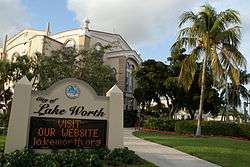
Development started again after World War II with many modest pensioners, especially from Quebec, Finland, and eventually Germany, moving to the city and building 1,000-square-foot (93 m2) cottages. These new immigrants brought their industrious nature with them as well as their native customs, restaurants, shops, and churches and for decades the town flourished. To this day, one can find an abundance of beer halls, chocolatiers, Bavarian delicatessens, and Lutheran churches, which stand out in the semitropical urban sprawl of South Florida.
The South Florida construction boom brought a new wave of immigrants in the past few decades. Central Americans have added a Hispanic aspect to Lake Worth's culture. Included in the 1980s immigration were many Guatemalan-Mayans who consider themselves indigenous people, rather than "Hispanic" or "Latino" and some may not speak Spanish. They mostly converse in Mam, Q'anjob'al, or any one of 22 existing Mayan languages spoken in Guatemala. Adding to the racial and linguistic mix of the city is a large Haitian population, speaking Haitian Creole and French.
During a short period of neglect and decline in the 1980s and 1990s, Lake Worth, in the words of then-city commissioner Dennis Dorsey, "had become known as the skin-flick capital of the country." The venue now known as the Lake Worth Playhouse was the Playtoy, and was well known in Palm Beach County as the theater that showed x-rated movies; Deep Throat was shown there, motivating a police raid in 1973.[25]
The downtown area has seen a huge resurgence in interest and now sports an array of art galleries, sidewalk cafés and night clubs. Once moribund property values have soared. The city's main street, Lake Avenue, contains some of the oldest commercial structures in South Florida, including the Art Deco Lake Worth Playhouse.
The city was hit especially hard by Hurricanes Frances, Jeanne, and Wilma in 2004 and 2005. The fishing pier was quite damaged but was repaired (with the help of FEMA) and reopened in May 2009. The pier is currently open to the public with entry fees of $1 per adult sightseer, and $3 per adult fisherman. The city's public swimming pool has been restored, and besides serving to instruct Palm Beach County residents in swimming and water safety, hosts water-sport competitions. The pier is home to a tide gauge with a sporadic history, showing an above average rate of sea level rise.[26]
In 2015, the city was accused of asking for business licenses from surrounding churches.[27]
In 2019 a ballot initiative to change the name of the city to Lake Worth Beach passed with a narrow margin.[28] The city states that the name change "will be implemented slowly".[29]
Geography
Lake Worth Beach is located at 26°37′11″N 80°3′31″W,[30] bordering West Palm Beach to the north, and Lantana to the south. 60 miles (97 km) north of Downtown Miami. According to the United States Census Bureau, the city has a total area of 6.46 square miles (17 km2), of which 5.64 square miles (15 km2) is land and 0.86 square miles (2 km2) (12.69%) is water.
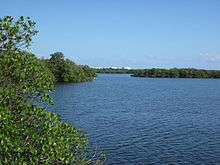
Several geographical features in Palm Beach County somewhat confusingly share the name "Lake Worth." The city of Lake Worth Beach is named after a lagoon which is officially known as the Lake Worth Lagoon. This lagoon opens to the Atlantic Ocean at the Port of Palm Beach via the Lake Worth Inlet. The next closest inlet exists further south in Boynton Beach. The port and two inlets are all distant from the actual city of Lake Worth Beach. The lake is a long channel that spans much of northern Palm Beach County; indeed, the Intracoastal Waterway traverses the length of the lagoon. The manmade inlets to the ocean have replaced the natural freshwater with saltwater, such that the lagoon is actually now a tidal body, instead of a true lagoon.
The U.S. Department of Agriculture has mapped most of Lake Worth Beach in the Southern Florida Flatwoods land resource area.[31]
Deep, poorly drained acidic sandy soils are typical for the area; they have gray topsoil, white subsoil, and a dark hardpan. Much of Lake Worth Beach is built on a rapidly drained white or gray sand which is too dry and infertile to support vigorous plant growth. The western outskirts of Lake Worth Beach are in the Southern Florida Lowlands area. Topsoils there are sandy, but the subsoils have a much higher content of clay and the soils are relatively fertile. As in the flatwoods, these soils are poorly drained for many purposes unless drainage systems are installed.[32]
Lake Worth Beach bills itself as "Where the Tropics Begin." Many tropical plants grow in the city; among the more prominent examples are mahogany, royal poinciana and many species of palm, including coconut palm. African tulip tree, avocado and many species of eucalyptus may also be found, although they are on the city's list of trees to avoid. Temperate-zone trees native to Lake Worth Beach or Palm Beach County include American elm, live oak, red maple, red mulberry, and slash pine. Species grown south of their native areas include American sweetgum, Shumard oak, and tulip tree.
Although the incorporated city of Lake Worth Beach is small geographically, as is common in Palm Beach County, a large unincorporated urbanized area with a Lake Worth postal address lies to the west of the city, and includes the census-designated place of Lake Worth Corridor. It also includes western neighborhoods and communities such as The Fountains, Lago Lucerne, Lake Osborne Estates, Melaleuca Lane Corridor, and Palm Beach National. The total population of both incorporated and unincorporated Lake Worth was estimated by the 2006 Census to be 190,377.
Demographics
| Historical population | |||
|---|---|---|---|
| Census | Pop. | %± | |
| 1920 | 1,106 | — | |
| 1930 | 5,940 | 437.1% | |
| 1940 | 7,408 | 24.7% | |
| 1950 | 11,777 | 59.0% | |
| 1960 | 20,758 | 76.3% | |
| 1970 | 23,714 | 14.2% | |
| 1980 | 27,048 | 14.1% | |
| 1990 | 28,564 | 5.6% | |
| 2000 | 35,133 | 23.0% | |
| 2010 | 34,910 | −0.6% | |
| Est. 2018 | 38,267 | [7] | 9.6% |
| U.S. Decennial Census[33] | |||
| Lake Worth Beach Demographics | |||
|---|---|---|---|
| 2010 Census | Lake Worth Beach | Palm Beach County | Florida |
| Total population | 34,910 | 1,320,134 | 18,801,310 |
| Population, percent change, 2000 to 2010 | −0.6% | +16.7% | +17.6% |
| Population density | 5,945.2/sq mi | 670.2/sq mi | 350.6/sq mi |
| White or Caucasian (including White Hispanic) | 60.0% | 73.5% | 75.0% |
| (Non-Hispanic White or Caucasian) | 38.1% | 60.1% | 57.9% |
| Black or African-American | 19.8% | 17.3% | 16.0% |
| Hispanic or Latino (of any race) | 39.6% | 19.0% | 22.5% |
| Asian | 1.0% | 2.4% | 2.4% |
| Native American or Native Alaskan | 5.6% | 0.5% | 0.4% |
| Pacific Islander or Native Hawaiian | 0.1% | 0.1% | 0.1% |
| Two or more races (Multiracial) | 4.6% | 2.3% | 2.5% |
| Some Other Race | 8.9% | 3.9% | 3.6% |
As of the census of 2010, there were 16,473 households, out of which 21.3% were vacant. The median income for a household in the city was $35,428 (2009–2013) and 32.3% of the population was below the poverty level.
As of 2000, the three most spoken first languages in Lake Worth Beach were English at 56.61%, Spanish at 26.57%, and French Creole which was spoken by 9.17% of the population.[34]
Lake Worth Beach has a large Finnish expatriate population, and Finnish is spoken by 2.57% of the city's residents as their native language. Other languages spoken by residents of the city include French at 1.96%, Mayan languages were spoken by 1.11% (primarily spoken by Guatemalans of Mayan descent), and German as a mother tongue was spoken by 0.52% of the population.[34]
As of 2000, Lake Worth Beach had the twentieth highest percentage of Guatemalan residents in the US, with 4.87% of the populace.[35] It had the twenty-first highest percentage of Haitian residents in the US, at 8.10% of the city's population,[36] and the eighty-third highest percentage of Cuban residents in the US, at 3.47% of its population.[37] It also had the twenty-third most Hondurans in the US, at 1.59% of all residents.[38] According to Census 2000, people of Finnish ancestry were 3.4% of the population.
With 1,026 people claiming Finn descent in 2000,[39] Lake Worth Beach has the second largest Finnish diaspora as a percentage of total population in the world. In addition, Lake Worth Beach has a large population of new immigrants from Latin America and the Caribbean. The downtown area has become a dynamic artistic and entertainment center in recent years. Some of South Florida's most attractive architecture can be found in College Park, an affluent neighborhood in the northeast corner of the city. The festival is an annual fundraiser which supports an array of social services for low to moderate income individuals and families.
Downtown
Lake Worth Beach's downtown area has distinct character and is a popular destination for both tourists and residents of South Florida. It is distinguished by its two main streets, Lake Avenue and Lucerne Avenue, and by the fact that most of its downtown buildings are historic and almost all of them are either one or two stories tall. Downtown Lake Worth Beach is home to the Art Deco Lake Worth Playhouse and the Lake Worth Historical Museum. Yearly festivals such as the Street Painting Festival[40] and Finlandia Week (a celebration of Lake Worth Beach's Finnish population) attract thousands of people. When combined with neighboring Lantana's Finnish community, it becomes the largest Finnish community in the United States. The largest Oktoberfest in South Florida is held every October just outside the city on Lantana Road. The City Tree Board organizes an annual "Lake Worth Festival of Trees," which usually takes place in the Cultural Plaza on the third Saturday in February, and the weekend before the Street Painting Festival. The city holds a semi-weekly celebration called "Evenings on the Avenue" which takes place in the Cultural Plaza, next to the City Hall Annex.
A substantial portion of the 1981 movie, Body Heat, starring William Hurt and Kathleen Turner, was filmed in downtown Lake Worth Beach.
Crime
Lake Worth Beach has a local reputation for high crime and has been counted as among the highest crime cities in the state.[41] The city's police department was disbanded in 2008 and law enforcement duties were taken over by the Palm Beach County Sheriff's Department.[42] Crime has been falling since then, with murders down 73%, robberies down 47% and burglaries down 23%.[43]
The city was part of the worsening opioid epidemic in the United States. From 2015 to 2016, the number of suspected drug overdose deaths rose by 56%. As of 2016 the estimated rate of overdose deaths was 20 out of every 10,000 people, higher than in neighboring towns.[44]
LGBT community
The annual Gay Pride Parade for Palm Beach County is held in Lake Worth Beach.[45] The county's only LGBT center, Compass, is located in Lake Worth Beach.[46]
Education
Public schools in Lake Worth Beach are part of the School District of Palm Beach County. There are four public elementary schools in Lake Worth: South Grade Elementary, North Grade Elementary, Highland Elementary and Barton Elementary.
Lake Worth Community High School, established in 1922, serves the city, along with Lake Worth Middle School.
Sacred Heart Catholic Church runs a separate private school (pre-K through 8).
There is also one charter school, the Academy for Positive Learning.
The main campus of Palm Beach State College is located in unincorporated Lake Worth. It is the oldest community college in Florida, founded in 1933 as Palm Beach Junior College. It was at one time located on the campus of Palm Beach High School, at the present day Dreyfoos School of the Arts in downtown West Palm Beach. The school moved to its present location in 1956. The name was changed to Palm Beach Community College in 1988. In 2010, it was changed to Palm Beach State College to reflect that the school was offering four-year degrees.[47]
Lake Worth Library
The Lake Worth Library was started by a group of local women in 1912, one year before the city was incorporated. For many years the library was housed in various municipal buildings. The Lake Worth Library Association raised $66,000 in donations for a building completed in 1941 without any support from tax money. The library is still housed in that building.[48]
Early pioneer women of Lake Worth Beach saw a need for a school and a library. They posted an advertisement in May 1912 on the Lucerne Herald, the local newspaper, to ask for book donations. Soon, donations arrived in West Palm Beach and Mr. and Mrs. John L McKissock rode seven miles on their bicycles to pick up the book donations. The locals soon had a reading room full of books and read using candle light. They were proud to say that the library was born two years before electricity and before the first school was established.For several years, the library was housed in City Hall. In 1926, the Lake Worth City Council called for a vote and the library was established under the Florida Statutes. The Lake Worth Public Library was organized and the assets of the Library Association formed by the pioneers were turned over to the Library Board.
In 1939, Congress passed a bill providing $60,000 in funding to erect a library in honor of General William Jenkins Worth; however, President Franklin D. Roosevelt vetoed this bill. The community came together and raised funds to build a library and finally, in 1941, the library was constructed and named Lake Worth Library. A dedicatory service was held in August 12, 1941. The citizens are very proud to say that their library was built without taxing the citizens or Federal assistance.
James and William Strait provided $10,000 to build an art museum wing. This wing was the home of the Art League until it moved to a bigger location. This wing is now the children's library collection. The library still feels like an Art Museum since it houses the only known collection of historic paintings by noted artist, R. Sherman Winton which features historical Florida themes of the Spanish Period. The library also houses wood carvings by Sam J. Schlappich, a local Lake Worth Beach artist who was featured in the Century of Progress Fair in 1933 and the World Fair 1939.
The Lake Worth Library is located in 15 North M Street, Lake Worth Beach, Florida, 33460, a Mediterranean type building in the heart of historic downtown Lake Worth Beach. They offer fun and extensive Children's Programs and community workshops. It is a part of the Library Cooperative of the Palm Beaches.
Public transportation
Lake Worth Beach is served by a Tri-Rail station of the same name. It is also served by PalmTran buses.[49]
Recreation
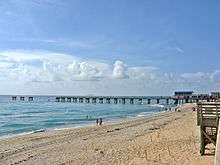
Lake Worth Beach has a bounty of public parks and open space. The Lake Worth is one of the last remaining large tracts of open, public space on the ocean in Southeast Florida. In 2013, the Casino building at the beach was reopened with great fanfare. The neoclassical building approximates the original 1920s Casino building that had stood overlooking the ocean until it was replaced by a more modern, boxy building after the 1947 hurricane.
The William O. Lockhart Municipal Pier, jutting into the Atlantic, is a recognizable symbol of the city; much of it was destroyed by Hurricane Frances in 2004, but has since been rebuilt and raised 5 feet (1.5 m). The pier creates sandbars which catch ocean swells, making Lake Worth Beach one of the most consistent surfing spots in South Florida.
Bryant Park, located in downtown Lake Worth Beach, has a 1920s-era bandshell which is used for festivals and other events. The nearby municipal golf course offers low-cost golfing with views of Lake Worth and Palm Beach beyond. On the west side of town, the county-owned John Prince Memorial Park follows the winding shores of Lake Osborne and offers several miles of bike and walking trails as well as hundreds of acres for picnicking, volleyball and overnight camping.
On February 29, 2012, the Snook Islands Natural Area was opened just to the north of Bryant Park. Amenities include a kayak launch, eight mooring slips, a fishing pier and nature walk around the mangroves of the southernmost of the Snook Islands. Dolphins, manatees and an assortment of tropical birds are commonly seen including herons, ibises, egrets, oystercatchers, pelicans, cormorants and other waterfowl.
Notable people
- Violet Englefield, actress and singer
- Kevin Fagan, former defensive end for the San Francisco 49ers
- Mark Foley, former United States congressman and a former elected city official
- Deidre Hall, actress and soap opera star
- Andy Hansen, Major League Baseball pitcher with the New York Giants (1944–50) and Philadelphia Phillies (1951–53)[50][51]
- Nicki Hunter, pornographic film director, producer and former pornographic actress
- Scott "Raven" Levy, pro wrestler[52]
- Joe Looney, offensive lineman for Dallas Cowboys (2012–present)[53]
- Julie Mayberry, Republican member of the Arkansas House of Representatives since 2015; journalist; former Lake Worth Beach resident
- Robin Morgan, radical feminist
- Herb Score, Major League Baseball player with the Cleveland Indians (1955–59) and Chicago White Sox (1960–62)[54]
- Mayo Smith, Major League Baseball player, manager, and scout
- Otis Thorpe, professional basketball player (1984–2001)
- Trea Turner, baseball player[55]
- Vanilla Ice, born Robert Van Winkle; has lived in Lake Worth Beach since the 2010s; rapper and house flipper
- Charles Whitman, mass murderer[56]
- Ghostemane, hip-hop recording artist[57]
- Brooks Koepka, golfer
Sister cities
See also
- Lake Worth Corridor, an unincorporated area outside the city limits of Lake Worth
References
- "Lake Worth, Florida Website". City of Lake Worth, Florida (Website Motto: June 9, 2013 to current date) via Wayback Machine. Archived from the original on June 9, 2013. Retrieved March 7, 2019.
- "Welcome to the City of Lake Worth, Florida: Where the Tropics Begin". City of Lake Worth, Florida (Website Motto: April 24, 1999 to June 1, 2013) via Wayback Machine. Archived from the original on April 24, 1999. Retrieved March 7, 2019.
- "Celebrating Our History: Before Lake Worth, there was Jewell". thecoastalstar.com. Retrieved March 7, 2019.
- "2016 U.S. Gazetteer Files". United States Census Bureau. Retrieved Jul 7, 2017.
- "Lake Worth, United States Page". Falling Rain Genomics. Retrieved 2007-10-07.
- "Florida growth outpaces national trend". USAToday. Retrieved 2010-01-19.
- "Population and Housing Unit Estimates". Retrieved July 23, 2019.
- "Lake Worth, FL ZIP Codes". zipmap.net. Retrieved March 7, 2019.
- "U.S. Census website". United States Census Bureau. Retrieved 2008-01-31.
- "US Board on Geographic Names". United States Geological Survey. 2007-10-25. Retrieved 2008-01-31.
- "Annual Estimates of the Population of Metropolitan and Micropolitan Statistical Areas: April 1, 2000 to July 1, 2006" (XLS). U.S. Census Bureau. Retrieved 2007-10-07.
- "Boynton Beach Indian Mounds - Jeaga - Boynton Beach.com". Retrieved 17 September 2016.
- Brownstein, Ted (2013). Pioneers of Jewell. Lake Worth, Florida: Lake Worth Herald Publications. pp. 50–51, 82–83, 100–104, 112–113. ISBN 978-0-9832609-4-3.
- Brownstein, Ted (2013). Pioneers of Jewell. Lake Worth, FL: Lake Worth Herald Publications. p. 118. ISBN 978-0-9832609-4-3.
- Lake Worth: Jewel of the Gold Coast, Jonathan W. Koontz, The Greater Lake Worth Chamber of Commerce, 1997, p. 20.
- Lake Worth Pioneer Association, http://www.lwpa.org/barefoot_mail_route.html Archived 2012-02-18 at the Wayback Machine
- Lake Worth: Jewel of the Gold Coast, Jonathan W. Koontz, The Greater Lake Worth Chamber of Commerce, 1997, p. 74
- Lucerne – The City Beautiful, Lucerne Herald, May 23, 1912
- Lake Worth Herald, February 28, 1963, p.12, reprint of Bryant & Greenwood promotional article entitled, The Eyes of the World are Turned Toward Lake Worth, 1912
- Palm Beach Neighborhood Times, March 28, 1974, p.1, "Early Resident Recounts Lake Worth History"
- "www.jcbserver.com". Archived from the original on 10 September 2012. Retrieved September 17, 2016.
- "Alfar Creamery (pdf)" (PDF). (from the files of the Historical Society of Palm Beach County and The Palm Beach Post.). Palm Beach County History Online.
- Mustaine, Beverly (1999). The Images of America: On Lake Worth. Charleston, S.C.: Arcadia Books. p. 55. ISBN 978-0-7385-0055-3.
- "Lake Worth's Boutwell Road Named After Area Dairyman". Historic Palm Beach Blog. Palm Beach Post. Archived from the original on 2015-05-15. Retrieved 2019-05-19.
- Frank Cerabino and Laura Lordi, "Our (se)X-rated history: A titillating tour of nudity in Palm Beach County," http://projects.mypalmbeachpost.com/nakedpalmbeachcounty/ Archived 2018-01-31 at the Wayback Machine
- "Mean Sea Level Trend 8722670 Lake Worth Pier". National Oceanic and Atmospheric Administration. |accessdate=December 30, 2016
- "Archived copy". Archived from the original on 2018-02-03. Retrieved 2019-01-29.CS1 maint: archived copy as title (link)
- https://www.sun-sentinel.com/news/politics/fl-ne-lake-worth-new-beach-name-20190312-story.html
- Swift, Tom (March 12, 2019). "Lake Worth changes its name to Lake Worth Beach". Local10.com. Retrieved March 13, 2019.
- "US Gazetteer files: 2010, 2000, and 1990". United States Census Bureau. 2011-02-12. Retrieved 2011-04-23.
- Map of Major Land Resource Areas in Florida (Map). United States Department of Agriculture. 1997. Archived from the original on 2008-03-28. Retrieved 2007-10-07.
- "Major Land Resource Areas in Florida". United States Department of Agriculture. Archived from the original on 2010-10-08. Retrieved 2007-10-07.
- "Census of Population and Housing". Census.gov. Retrieved June 4, 2015.
- "MLA Data Center Results for Lake Worth, Florida". Modern Language Association. Retrieved 2007-10-06.
- "Ancestry Map of Guatemalan Communities". Epodunk.com. Archived from the original on 2007-11-07. Retrieved 2007-11-20.
- "Ancestry Map of Haitian Communities". Epodunk.com. Archived from the original on 2012-12-11. Retrieved 2007-11-20.
- "Ancestry Map of Cuban Communities". Epodunk.com. Retrieved 2007-11-20.
- "Ancestry Map of Honduran Communities". Epodunk.com. Archived from the original on 2010-10-17. Retrieved 2007-11-20.
- "Fact Sheet, Lake Worth city, Florida". US Census Bureau. Archived from the original on September 21, 2007. Retrieved 2007-10-06.
- Street Painting Festival
- Todaro, Chelsea (Feb 28, 2018). "Report: 2 Palm Beach County cities among most dangerous in the U.S." the Palm Beach Post. Retrieved 6 July 2018.
- Musgrave, Jane (December 23, 2017). "Court gives ex-cop another shot at disability benefits from Lake Worth". the Palm Beach Post. Retrieved 6 July 2018.
- Thompson, Kevin (August 14, 2015). "Fourth most dangerous city in state? This local city takes exception". the Palm Beach Post. Retrieved 6 July 2018.
- Velzer, Ryan Van. "Amid opioid crisis, a look at Palm Beach County's worst-affected cities". Sun-Sentinel.com. Retrieved 2018-01-28.
- "PrideFest Parade 2017,"https://www.facebook.com/pg/CompassCenter/photos/?tab=album&album_id=10155887988051124, retrieved August 3, 2017.
- Mike Halterman, "Discover Gay Florida - Palm Beach County," HOTspots, August 19, 2015, https://hotspotsmagazine.com/2015/08/19/discover-gay-florida-palm-beach-county/
- "History of Palm Beach State College". Palm Beach State College. Archived from the original on 2017-06-18. Retrieved 2017-10-16.CS1 maint: BOT: original-url status unknown (link)
- Engoren, Jam (April 17, 2019). "Lake Worth's 'quirky' library celebrates 75 years". Sun-Sentinel. Retrieved April 17, 2019.
- "Bus Service Fixed Route". Archived from the original on 6 September 2016. Retrieved 17 September 2016.
- Andy Hansen Statistics Baseball-Reference.com
- Inc., Baseball Almanac. "Andy Hansen Baseball Stats by Baseball Almanac". Retrieved 17 September 2016.
- "Raven Interview". The Miami Herald. 2004. Retrieved 2011-03-04.
- "Archived copy". Archived from the original on 2015-02-03. Retrieved 2018-12-24.CS1 maint: archived copy as title (link)
- Herb Score, Big League Star who Pitched at Lake Worth, Dies at 75. Palm Beach Post, November 11, 2008,
- "N.C. State's Trea Turner combines power with speed". Fayobserver.com. 2013-06-15. Retrieved 2013-07-28.
- http://www.palmbeachpost.com/news/crime--law/demons-and-doom-the-whitmans-lake-worth/Tusw43X7mPm4qI4xree3lK/
- "Ghostemane's Hardcore Past Inspired His Underground Rap Presence".
- "Twin cities". Retrieved 29 April 2014.
External links
| Wikimedia Commons has media related to Lake Worth, Florida. |
